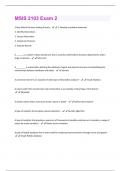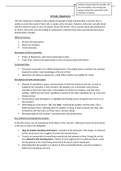Biology
Heart
1. How many stages does the cardiac cycle have? - 3
2. What is the first stage of the cardiac cycle - atria systole
3. What is the second stage of the cardiac cycle? Ventricular systole
4. What is the last stage of the cardiac cycle - diastole
5. Describe atrial systole - when both left and right arias contract
with allow blood to be forced into the ventricles.
6. Describe ventricular systole - ventricles contract from the bottom
up so that blood is squeezed upwards into the atrium. There is no back
flow due to the atrioventricular valve.
7. Describe diastole - The atria and the ventricles relax so that the
atria can fill up will blood ready for the next cycle.
8. What is the role of the semilunar valves - Moves blood from the
heart to the other parts of the body by preventing backwards blood
flow.
9. What is the role of the atrioventricular valve - Prevents back flow
of the blood from the ventricles to the atrium during ventricular
contractions.
10. What is the function of the vena cava - Returns deoxygenated
blood from the head to the body then to the right atrium of the heart.
11. What is the role of the septum in the heart - The septum divides
the heart into the left and right sides.
12. What is the role of the pulmonary vein - Transports oxygenated
blood from the lungs to the left atrium.
13. What is the role of the pulmonary artery - carries deoxygenated
blood from the right ventricles to the lungs.
14. What is cardiac output - the amount of blood that is pumped out
by the heart per minute.
15. What is the equation for cardiac output - heart rate (beats per
minute) x stroke volume (volume of blood being pumped out per beat)
16. What is the main artery in the heart and where does the blood
travel - Aorta is the main artery and it carries blood from the heart to
the body.
17. What is the superior vena cava - a large vein (vena means vein)
that takes blood from the upper limbs of the body e.g. the head to the
heart. (Superior means above so upper body to the heart)
18. What is the inferior vena cava - take blood from the lower body
part to the rest of the body (inferior means lower so lower body part to
the heart).
19. The heat is myogenic what does this mean? - It beats on its own
due to electrical signals.
Heart
1. How many stages does the cardiac cycle have? - 3
2. What is the first stage of the cardiac cycle - atria systole
3. What is the second stage of the cardiac cycle? Ventricular systole
4. What is the last stage of the cardiac cycle - diastole
5. Describe atrial systole - when both left and right arias contract
with allow blood to be forced into the ventricles.
6. Describe ventricular systole - ventricles contract from the bottom
up so that blood is squeezed upwards into the atrium. There is no back
flow due to the atrioventricular valve.
7. Describe diastole - The atria and the ventricles relax so that the
atria can fill up will blood ready for the next cycle.
8. What is the role of the semilunar valves - Moves blood from the
heart to the other parts of the body by preventing backwards blood
flow.
9. What is the role of the atrioventricular valve - Prevents back flow
of the blood from the ventricles to the atrium during ventricular
contractions.
10. What is the function of the vena cava - Returns deoxygenated
blood from the head to the body then to the right atrium of the heart.
11. What is the role of the septum in the heart - The septum divides
the heart into the left and right sides.
12. What is the role of the pulmonary vein - Transports oxygenated
blood from the lungs to the left atrium.
13. What is the role of the pulmonary artery - carries deoxygenated
blood from the right ventricles to the lungs.
14. What is cardiac output - the amount of blood that is pumped out
by the heart per minute.
15. What is the equation for cardiac output - heart rate (beats per
minute) x stroke volume (volume of blood being pumped out per beat)
16. What is the main artery in the heart and where does the blood
travel - Aorta is the main artery and it carries blood from the heart to
the body.
17. What is the superior vena cava - a large vein (vena means vein)
that takes blood from the upper limbs of the body e.g. the head to the
heart. (Superior means above so upper body to the heart)
18. What is the inferior vena cava - take blood from the lower body
part to the rest of the body (inferior means lower so lower body part to
the heart).
19. The heat is myogenic what does this mean? - It beats on its own
due to electrical signals.




